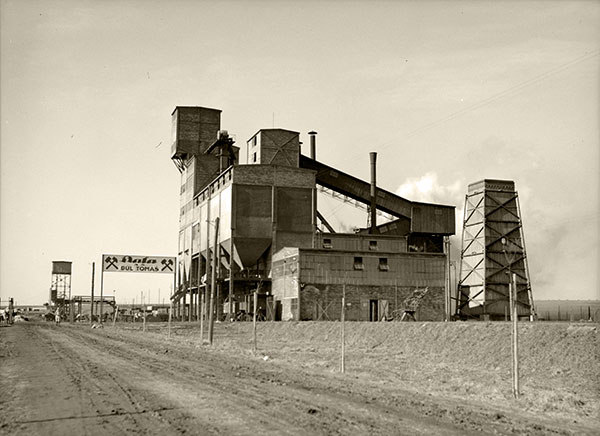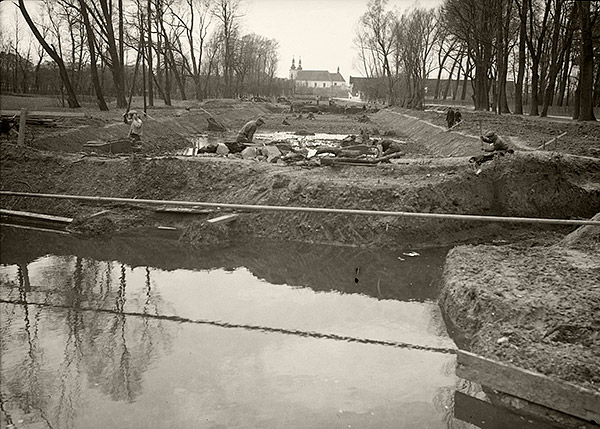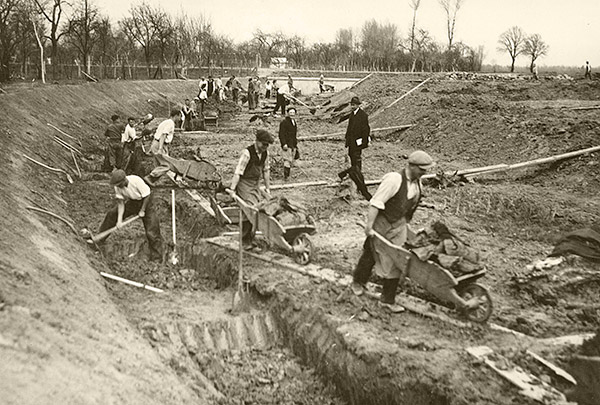 Tomáš mine in the village of Ratíškovice 1936
Tomáš mine in the village of Ratíškovice 1936
Construction, maintenance, reconstruction
The works on the Bata Canal began, as already mentioned, in October 1934. The first problem came soon. In the Strážnice area, a strike broke up as the workers did not agree with wage conditions. In their opinion, the wages did not correspond to local circumstances and they were not high enough to support their families. Because the construction project was supposed to employ as many people as possible, the construction management tried to have most works done manually. For this reason, almost everything was carried out by hand at earthenworks —and this was exactly the thing about which the workers complained: that they needlessly slave over the labour which could be easily carried out by machines. Based on these complaints, several labours were mechanized.
During the first half of the year 1935, the work progressed quickly. Several companies participated in the construction: in the section below the town of Napajedla the Eng. Bartoš Company from Břeclav employed about 160 people; in the section Spytihněv — Staré Město 80 people worked for the Eng. Černý Company and 60 people for the Eng. Jaroš Company; the passage in the Kunovský Forest was built by the Eng. Souček Company from Prostějov with 140 workers; the canal section Vnorovy — Rohatec was delivered by the Lejsek and Soušek Company with 270 workers; in the section Strážnice — Petrov worked the Eng. Ženatý and Volenec Company with 170 people. The workers were hired mainly for excavating works, bank enforcement, and preparation of lock constructions.
In 1936, more specialized works started, meaning the construction of locks which were to provide sufficiently high water level in the river and to allow the vessels, sailing up the river, to navigate over height difference of 186 metres. Lock chambers were a section with two gates which closed after the vessel was floated into the chamber, and the water running into the chamber raised the vessel by a half meter or a meter. The vessels were drawn by draughthorses or tractors into the lock chambers, on the river they were towed by towboats with the speed of 5 km per hour.
To accelerate the works on the Morava River nearby the village of Nedakonice, the Bata Company lent the amount of CZK 350 000 to the Land Moravia-Silesia in September 1936. Also President Dr Edvard Beneš expressed his interest in the large water-engineering works during his first official visit to Moravia.
In summer months 1937, works on the Bata Canal culminated. Beside the original riverbed, new canals were excavated which waited for water from the Morava River. In late July 1937, the riverbed was transferred to an artificial canal in the section Spytihněv-Staré Město. The men employed at the construction experienced a fascinating event. A narrow strip of land, separating the river from the artificial canal, became so thin that the waterstream could burst it and fill-up the new canal within a few minutes to return then obediently to its original riverbed.
 Canal construction in Strážnice where it goes through the park 1936
Canal construction in Strážnice where it goes through the park 1936
 Construction of the Spytihněv – Staré Město section
Construction of the Spytihněv – Staré Město section
Lively building activities did not quieten down in Otrokovice either. The workers had to run the canal into the Bata Works premises in a complicated way, as the canal route was crossed by phone network, sewage system, and plots of four family houses there. In order to allow the vessels to navigate into the factory premises, the factory management had a 760-metre-long canal built, which crossed the factory premises along the tanneries to the power plant. The Škoda Works began to build a structure for suction equipment for brown coal unloading there, whereby the coal was supposed to be transported on vessels from the Tomáš Mine in Ratíškovice.
Moravian archive in Brno, State district archive in Zlín